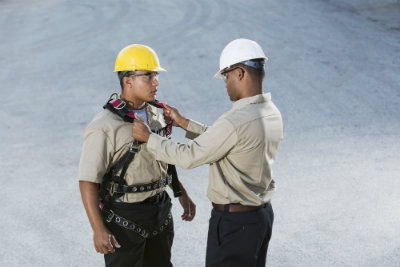As secretariat of the ANSI-accredited Z359 standards committee, ASSP collaborates with a diverse group of stakeholders to develop consensus standards that address work-related falls, which continue to be a leading cause of injuries and fatalities.
The Bureau of Labor Statistics reports that, from 2011 to 2016, the number of fatal work injuries from falls, slips or trips increased by 25 percent. Statistics such as these emphasize the need for comprehensive fall protection standards, which address best practices for preventing work-related falls.
Recently, ANSI/ASSP Z359 fall protection/restraint standards have been referenced in a number of industry documents and communications, as agencies and organizations align their codes and requirements with different aspects of the standards. These references demonstrate the importance of industry consensus standards such as Z359 toward establishing best practices for occupational safety and health in the U.S. and around the globe.
OSHA
In a 2017 letter of interpretation, OSHA clarified its stance on the requirements for gate strength of snaphooks and carabiners, as well as what constitutes a ‘qualified’ person who is able to conduct fall protection training. The letter states that OSHA did not intend to require gate strength testing of each snaphook and carabiner to 3,600 lbs. in each direction, but rather to be consistent with ANSI/ASSP Z359.12.
Accordingly, OSHA plans to issue a technical amendment to §1910.140(c)(8), which states that “the gate strength of snaphooks and carabiners must be capable of withstanding a minimum load of 3,600 lbs. without the gate separating from the nose of the snaphook and carabiner body by more than 0.125 inches.”
In addition, after examining the trainer and competent person requirements of ANSI/ASSP Z490.1-2016 and ANSI/ASSP Z395.2-2017, OSHA says it will “consider that a trainer who is a designated competent person and meets all of the requirements for trainers and competent persons in ANSI/ASSP standards is a ‘qualified’ person for purposes of the final rule [§§1910.21(b) and 1910.30 (a)(2)].”
The letter also notes that “the responsibilities that ANSI/ASSP Z359.2-2017 (§4.4) requires competent persons to perform and the extensive training they must have (§5.3) clearly indicates that a competent person has ‘ability to solve or resolve problems relating to the subject matter, the work or the project’ that the final rule requires [§1910.21(b)].”
International Building Code
In its most recent update to the International Building Code (IBC), the International Code Council (ICC) has referenced ANSI/ASSP Z359.1-2016, The Fall Protection Code, in regard to mechanical equipment, systems and devices (Section 1015.6) and roof access (Section 1015.7).
These sections now include an exception stating that guards are not required where personal fall anchorage connector devices that comply with ANSI/ASSP Z359.1 are installed. These references are significant due to that fact that compliance with the IBC is required for any building constructed anywhere in the world. The inclusion of references to Z359 in such a document is a major acknowledgment of the importance of the standard and how its use can help lead to safer workplaces.
U.S. Army Corps of Engineers
The U.S. Army Corps of Engineers (USACE) recently announced that the fall protection training requirements for USACE and contractor employees contained within its EM 385-1-1, Safety and Health Requirements Manual, will be updated to align with the ANSI/ASSP Z359 Fall Protection Code.
In addition, EM 385-1-1 will also state that training “shall be conducted and documented by a ‘Competent Person’ trainer in accordance with ANSI/ASSP Z359.2.” The manual includes the types of training required for different employees including fall protection program managers, authorized rescuers and end users.
Updated April 18, 2018